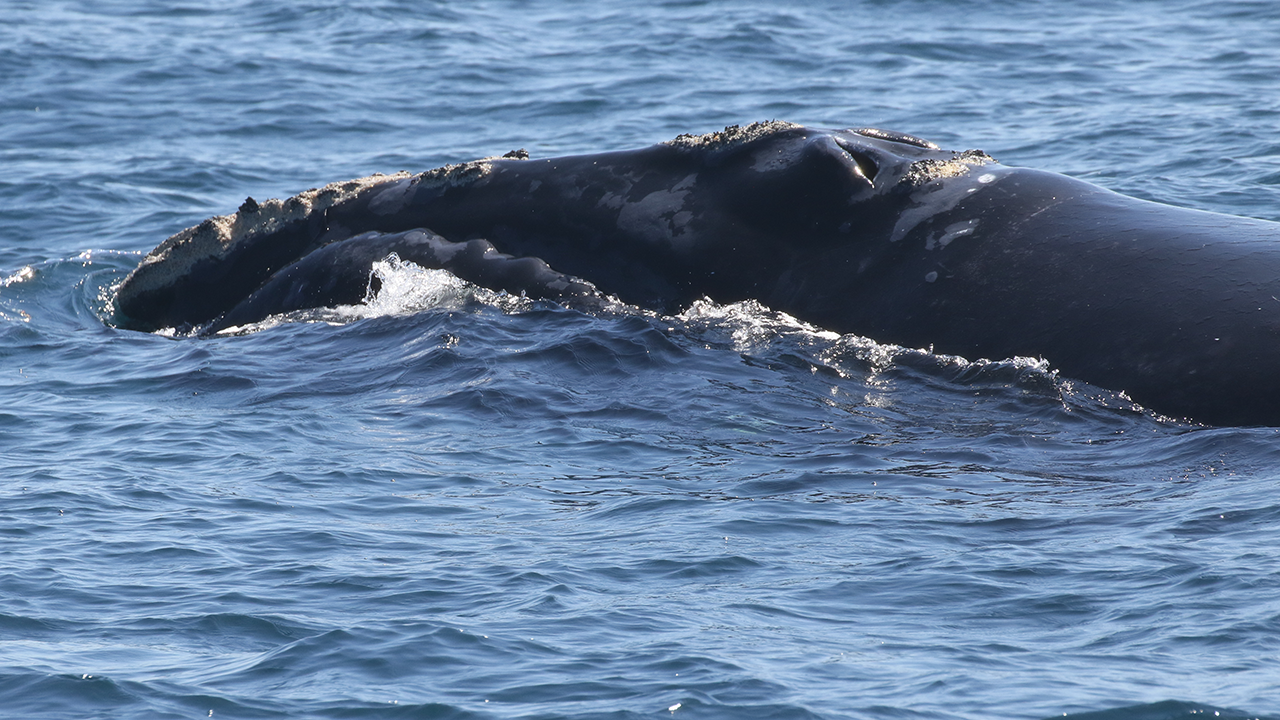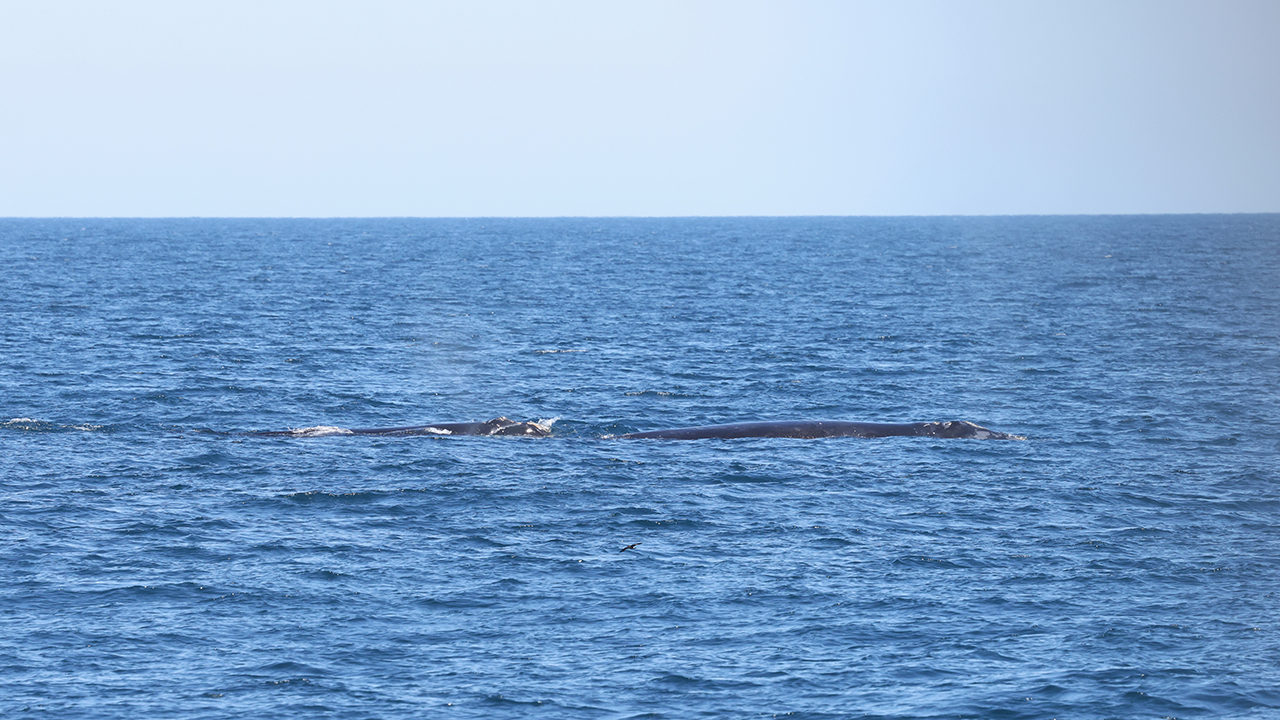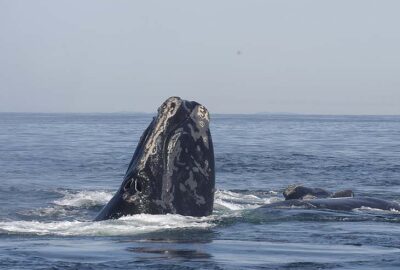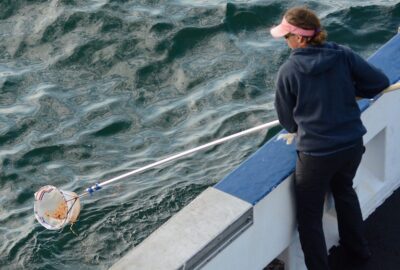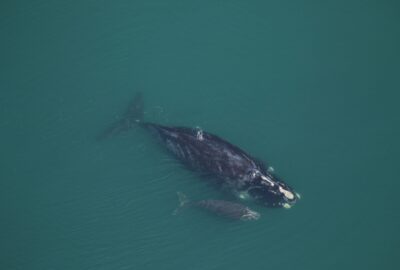2023–2024 North Atlantic Right Whale Mother and Calf Pairs
By New England Aquarium on Wednesday, November 29, 2023

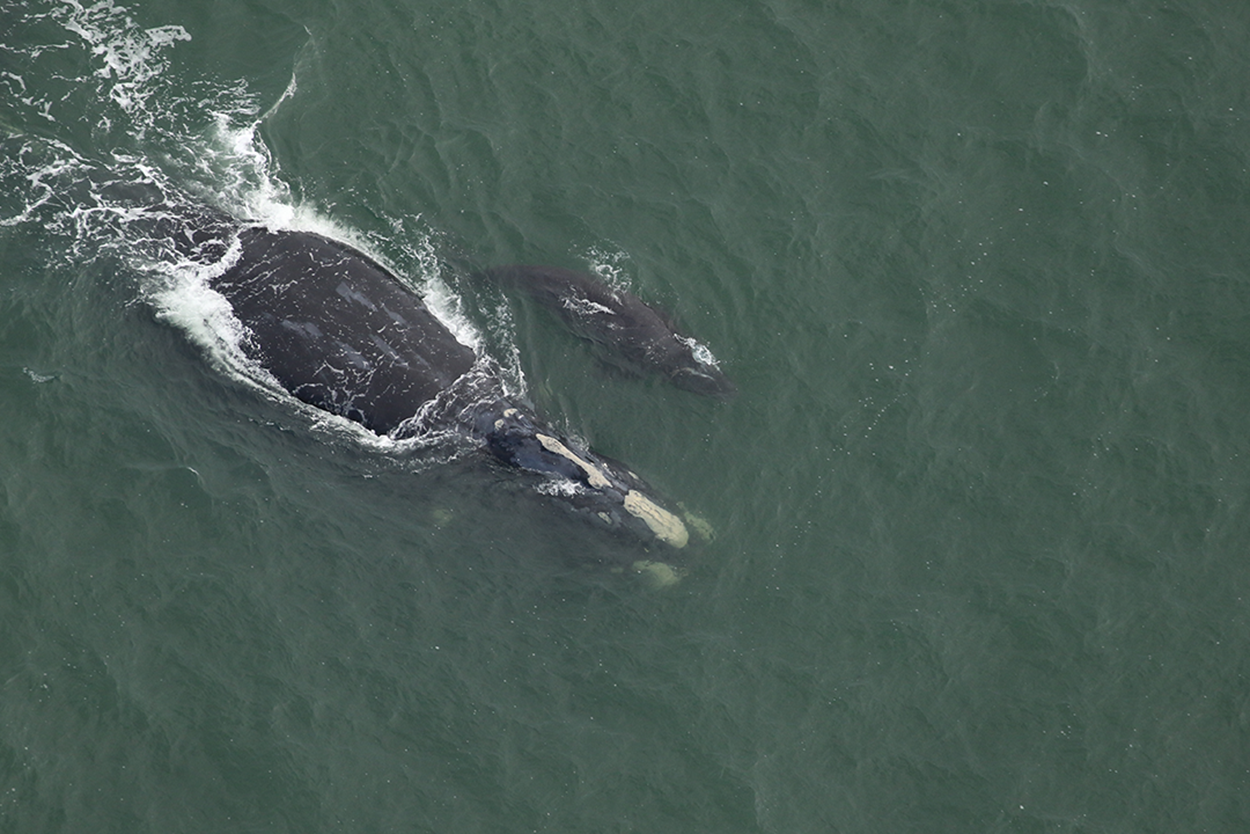
From December through March, during “calving season,” right whales and their young can be spotted together in the waters off the Southeastern coast of the United States, where the whales migrate to give birth. During this time, researchers on and above the water keep their eye out for whale mothers and their calves, a hopeful sight for the survival of these critically endangered marine animals.
With the apparent slowing decline of the right whale population, as scientists estimate 356 right whales remaining, new calves are critical if the species is to rebound. However, the number of calves born each year is about equal to the number of annual right whale deaths—highlighting the importance of ongoing measures to protect these animals from human-caused threats such as entanglements and vessel strikes. Researchers at the New England Aquarium’s Anderson Cabot Center for Ocean Life are working diligently to learn more about and protect this species, from right whale biologists conducting research via boats and planes to working in the laboratory to study their health and hormones.
Throughout calving season, right whale researchers manage a detailed list of mom and calf pairs with biographical information that includes photographs, lineage, where the whales were last seen, how they were named, and the challenges each whale has faced. This data comes from the North Atlantic Right Whale Catalog, which is maintained by researchers with the Aquarium.
Calving season ends as the whales move back north for the spring and summer. During the 2023-2024 season, there were twenty mother and calf pairs sighted, with the final sighting of Pico’s (Catalog #3270) calf coming as a late addition in early June. Sadly, one calf born to mother Juno (Catalog #1612) died, and four other calves are not expected to survive—born to Catalog #3780, Half Note (Catalog #1301), Catalog #1950, and Skittle (Catalog #3260). While every right whale birth is a reason to celebrate, many more healthy calves are needed to sustain this critically endangered species.
Meet this year’s mother and calf pairs below, and learn more about what you can do to help protect right whales here.
Recent sightings
/
Pico – Catalog #3270
Birth year: Unknown
Age: >22 years old
Last calving year: 2019
Previous calves: Catalog #4170, Catalog #4970
Other known relatives: N/A
Direct human impacts: 4 entanglements
Human impacts on family members: 2 entanglements
Pico (Catalog #3270) surprised us with a late addition to the calving season! She was seen with a calf by the HDR research team off the coast of Virginia on June 1, 2024. Pico was last seen off the coast of North Carolina in December 2023 but did not yet have a calf with her. Pico was first seen in 2002, and this is her third known calf. Her two previous calves are still seen regularly, and her latest calf, Catalog #4970, was even seen by our own research team in Cape Cod Bay this spring. Pico is famous for journeying to the Azores in 2009, where she was documented near Pico Island, which became her namesake. She’s potentially the only whale in our catalog with a documented sighting around the Azores.
While not impossible, these late additions to the calving season are not common, given the extensive survey effort throughout the Southeastern US calving grounds. According to our scientists’ assessment of the calf’s size, it was likely born earlier in the year, during the regular calving season.

Dog-Ear – Catalog #3590
Birth year: 2005
Age: 19 years old
Last calving year: N/A
Previous calves: None
Other known relatives: Mother, 2 siblings, 2 nieces and 1 nephew
Direct human impacts: 3 vessel strikes and 1 entanglement
Human impacts on family members: 7 entanglements and 1 vessel strike
Dog-Ear (Catalog #3590) was seen with a calf off the coast of Florida by a local fisher who reported the sighting to local authorities on February 16, 2024. Dog-Ear was born in 2005 to Catalog #1013, and this is her first known calf at the age of 19. An injury has caused the tip of her fluke (tail) to be folded over, like a dog-eared page in a book, which is how she earned her name. Dog-Ear has two known siblings (Nauset – Catalog #2413 and Catalog #2713) and three other relatives that were never cataloged.
Dog-Ear has experienced at least three vessel strikes, though none of them were too severe. What’s most surprising is that those events and her known entanglement all occurred by the age of four years old, and she has somehow managed to stay injury-free for the past 15 years. Hopefully, she is sharing her learned knowledge of avoiding boats and ropes with her first calf.

Skittle – Catalog #3260
Birth year: Unknown (first seen in 2002)
Age: >22 years old
Last calving year: 2010
Previous calves: 1 (Catalog #4096)
Other known relatives: N/A
Direct human impacts: 4 entanglements
Human impacts on family members: N/A
Updated April 18, 2024
Sadly, Skittle was only seen with her calf once, and the calf appeared to have a thin body condition, suggesting it was not thriving. After a recent sighting of Skittle without her calf, the calf is presumed dead.
—
Skittle (Catalog #3260) was seen with her second known calf on February 16, 2024, by Clearwater Marine Aquarium’s North Carolina team. Skittle’s age is unknown, but she was first seen in 2002 and gave birth to her first known calf in 2010. Unfortunately, that 2010 calf (Catalog #4096) likely died on the calving grounds as Skittle was seen several times without her calf, which was too young to be alone at the time. While it’s sad when calves are lost for unknown reasons, it’s a good reminder that not all young survive in nature.
Skittle’s name comes from the shape of her callosity pattern, which resembles the bowling pin used in the traditional British sport of Skittles, which is related to modern-day nine-pin bowling. Skittle doesn’t have any other known family members. She’s been entangled at least four times and, in one of these events, she was seen with rope and a buoy in her mouth. Luckily, she was able to shed the gear herself before the entanglement got too much worse.
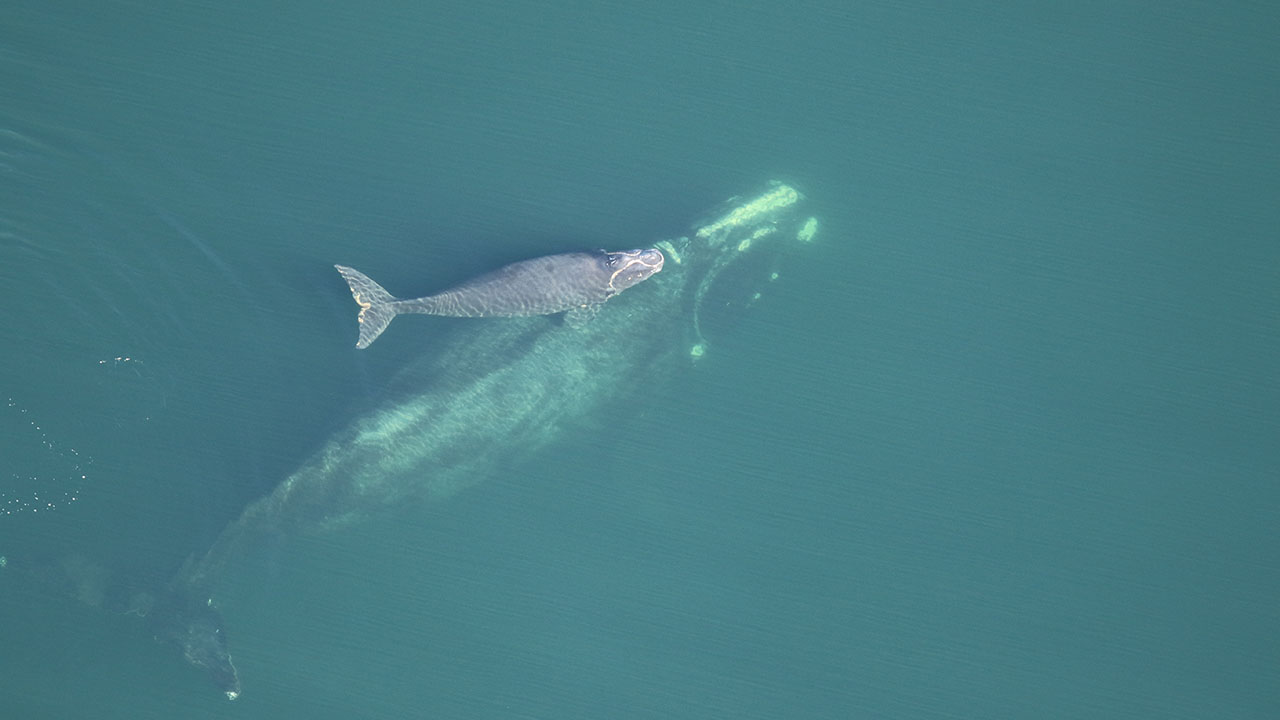
Catalog #3725
Birth year: 2007
Age: 17 years old
Last calving year: N/A
Previous calves: None
Other known relatives: Parents, 9 siblings, 7 nieces/nephews, 4 great nieces/nephews
Direct human impacts: 2 entanglements
Human impacts on family members: 23 entanglements and 1 vessel strike (parents and siblings only)
Catalog #3725 is another first-time mom this season! She was seen with her first known calf on January 30, 2024, by Florida Fish & Wildlife. She is also the 17-year-old daughter of Butterfly, another mom this season, and this calf makes Butterfly a grandmother! Catalog #3725 was born in 2007 to mom Butterfly (Catalog #1425) and father Catalog #1037. Thanks to the large extended family, mostly on her father’s side, Catalog #3725 is a great-aunt.
With such a large extended family, it’s no surprise the number of human impacts these animals have collectively faced. Catalog #3725 has survived two entanglements, but some of her family hasn’t been as lucky. Two of her siblings (Catalog #2425 and Catalog #3125) haven’t been seen since their major injuries (mentioned below in Butterfly’s bio), and her great-nephew died at the young age of 10. However, out of her 22 known family members, 13 of them have been seen in recent years. These are not the best odds, given the eldest whale in the group is ~44 years old, and right whales are believed to have a natural lifespan of 60+ years.
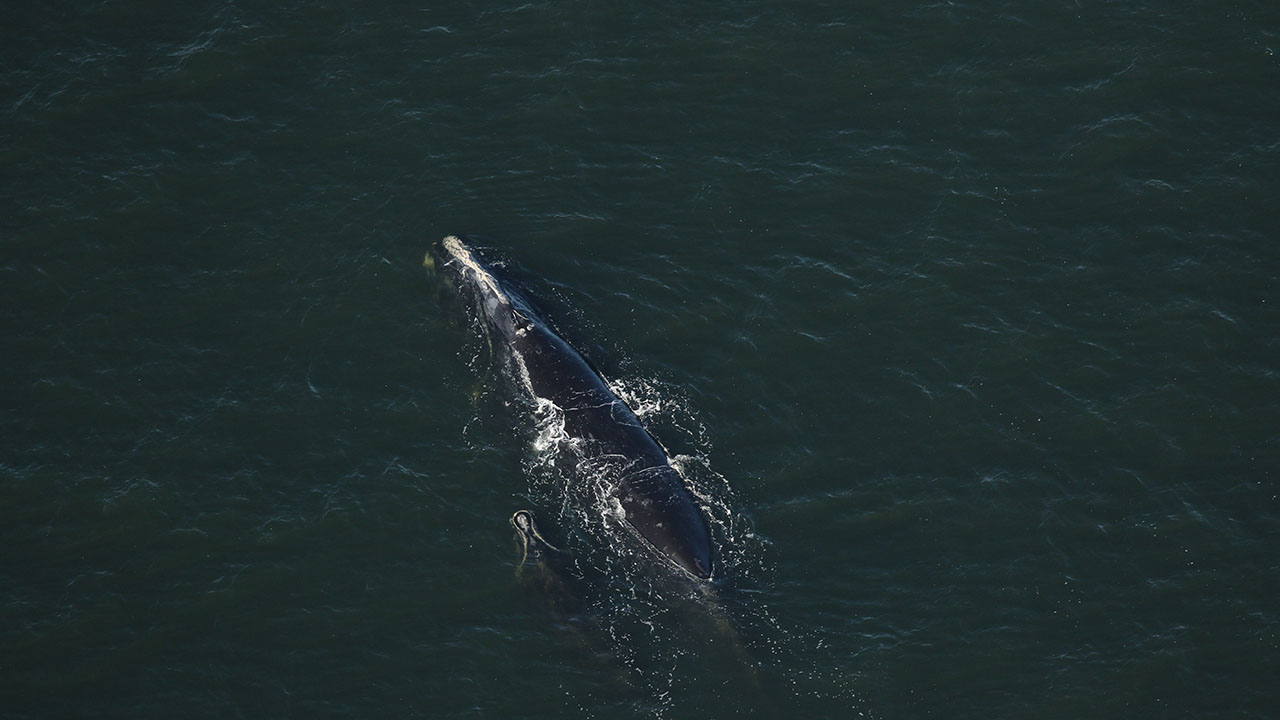
Butterfly – Catalog #1425
Birth year: Unknown (first seen in 1982)
Age: >42 years old
Last calving year: 2014
Previous calves: 4 (Catalog #2425, Catalog #3125, Catalog #3725, Catalog #4425)
Other known relatives: N/A
Direct human impacts: 4 entanglements
Human impacts on family members: 9 entanglements and 1 vessel strike
Updated July 2, 2024
Butterfly and her calf were spotted 15 miles southeast of Jonesport, Maine, by the Aquarium’s Anderson Cabot Center for Ocean Life aerial survey team! Researchers observed the calf nursing and happily reported that the young whale appears to be quite plump.
—
Butterfly (Catalog #1425) was seen with her fifth known calf on January 27, 2024, by Florida Fish & Wildlife. Butterfly was first seen in 1982; her exact age is unknown, but she’s been documented for 42 years. She was named for a feature in her callosity pattern, which looks like paired butterfly wings. Butterfly’s newest calf comes ten years after her last calf, once again following the longer calving interval we’ve been seeing in recent years.
Butterfly has been reasonably lucky with four minor entanglements, but her offspring haven’t gotten off as easy. Her first calf, Catalog#2425, was struck by a vessel at the age of 11, and though she survived the initial strike, she disappeared a few months later and hasn’t been seen since. Her second calf, Catalog #3125, hasn’t been seen since his severe entanglement in 2019 and was 18 years old at the time. Her last two calves both had significant entanglements at young ages but have survived those injuries and are now 17 and 10 years old.
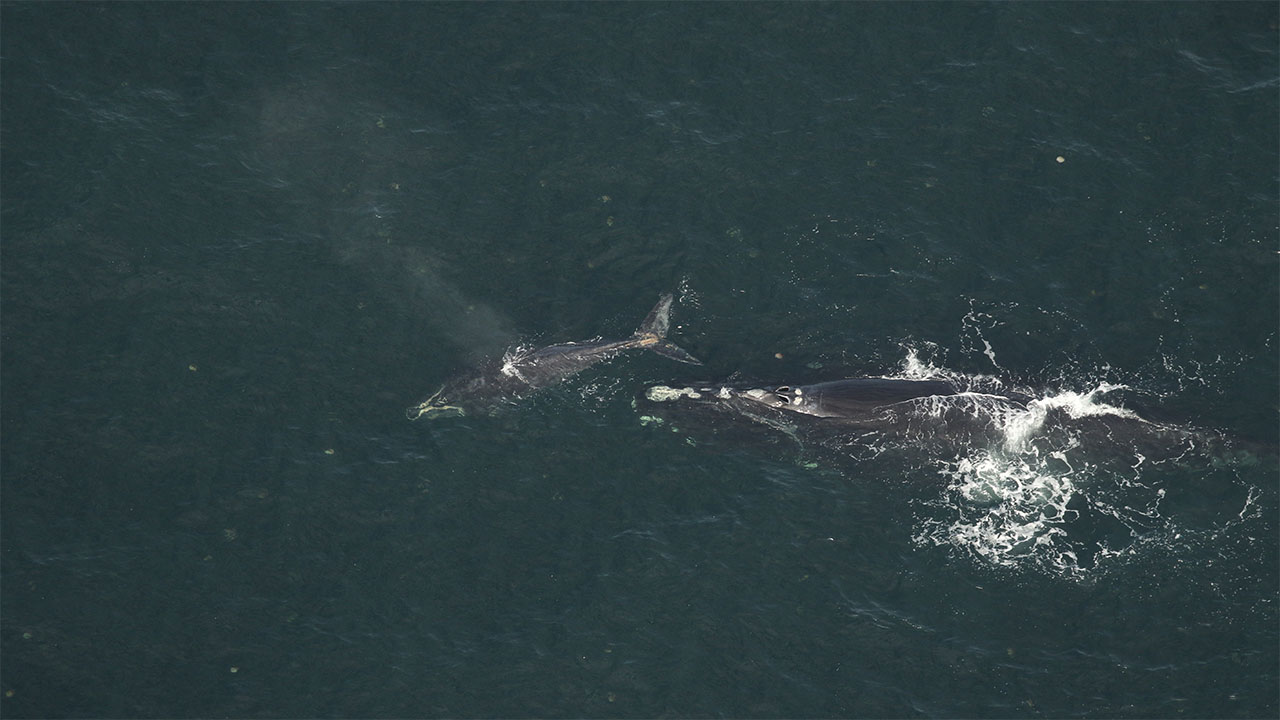
Catalog #3820
Birth year: 2008
Age: 16 years old
Last calving year: N/A
Previous calves: None
Other known relatives: Mother, brother
Direct human impacts: 2 entanglements
Human impacts on family members: 3 entanglements
Catalog #3820 was seen with her first known calf off the coast of Florida on January 24, 2024, by Florida Fish & Wildlife. Catalog #3820 is 16 years old, this is her first calf, and is only the second first-time mom of the season, so far. She was the first-born to her mother, Giza (Catalog #3020) in 2008. She has a three-year-old brother Catalog #5191. Luckily, her family has only seen five minor entanglements, though Catalog #3820 is a good example of the recent trend of females waiting longer to have their first calf. Historically, females were having their first calves around the age of 10, but lately, many first-time moms are 15–20 years old. This longer development period, coupled with longer calving intervals will slow population growth—especially as entanglements and vessel strikes continue to be major threats.
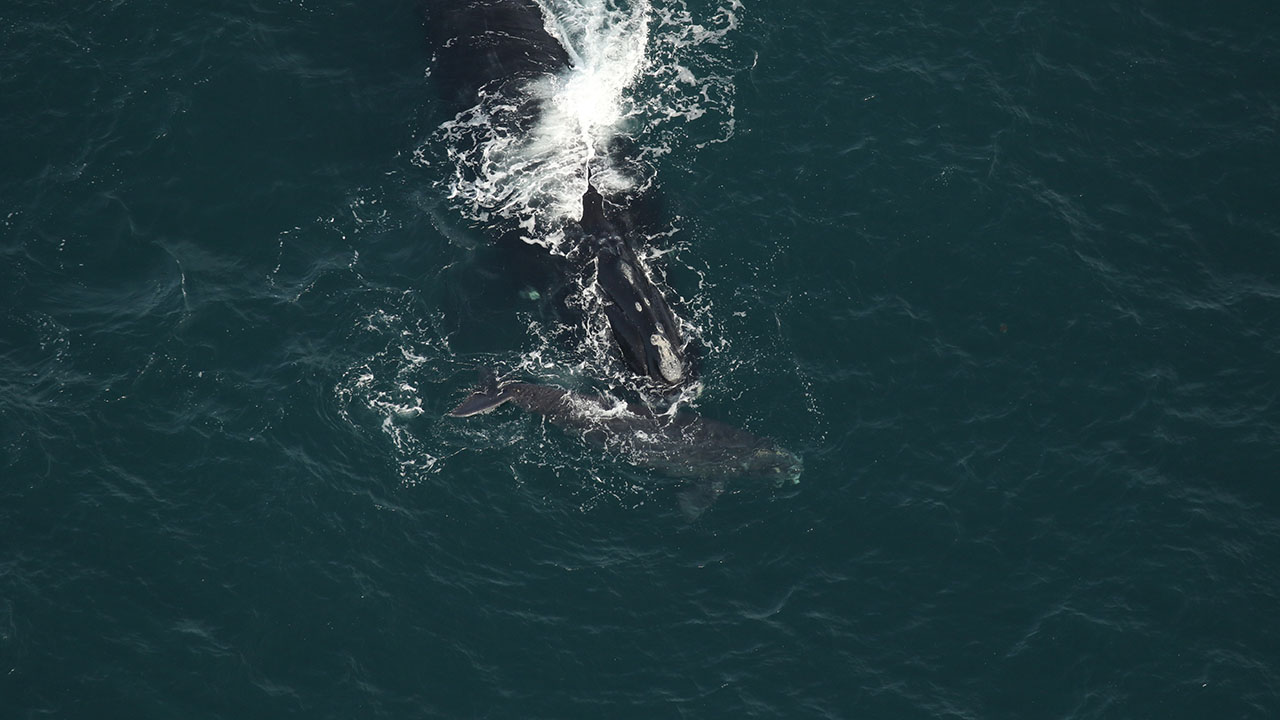
Marilyn Monroe – #3130
Birth year: 2001
Age: 23 years old
Last calving year: 2021
Previous calves: 3 (Catalog #3810, Catalog #3760, and an uncatalogued calf in 2021)
Other known relatives: Mother, father, 3 siblings, 4 nieces and nephews
Direct human impacts: 2 entanglements
Human impacts on family members: 28 entanglements and 1 vessel strike
Marilyn Monroe was seen with a new calf on January 17, 2024, by Florida Fish & Wildlife. Marilyn Monroe (the whale) was born in 2001 to mother Catalog #2240 and father Gemini (Catalog #1150). She is 23 years old, and this is her fourth known calf. She was named after the actress in 2023 because she has a scar on the front of her rostrum that is reminiscent of Marilyn Monroe’s beauty mark. Generally speaking, compared to maternity data, there is far less paternity data in the Right Whale Catalog, but Marilyn Monroe’s family has quite a bit of it; all her siblings are from her father, Gemini, including a fan favorite: Callosity Back (Catalog #3670) named because she is one of the only right whales documented with callosity on her back (callosities are typically only on the head).
Marilyn Monroe’s family (parents, siblings, and offspring) have endured a combined 30 entanglements and a fatal vessel strike. Her brother Peanut (Catalog #2140) was found dead in 2017 from a vessel strike injury, and her mother hasn’t been seen since 2005, when she was looking in poor health from a severe entanglement. Her first two calves have experienced three entanglements each but are still seen regularly, as is her 2021 calf, which will hopefully be cataloged soon!

Catalog #1950
Birth year: Unknown (first seen in 1989)
Age: >35 years old
Last calving year: 2015
Previous calves: 5 (Catalog #2750 – Haley, Catalog #3350, Catalog #3650, Catalog #4050, Catalog #4550)
Other known relatives: N/A
Direct human impacts: 3 entanglements
Human impacts on family members: 17 entanglements and 1 vessel strike
Updated April 2, 2024
Unfortunately, NOAA has announced that Catalog #1950 has been found dead. Her carcass was located 50 miles off the coast of Virginia on March 30. The whale was last seen healthy and with her calf on February 16 off Amelia Island, Florida. The calf, which aerial survey teams have been unable to locate, is not expected to survive without its mother. A necropsy revealed the cause of death was a vessel strike.
—
Catalog #1950 was seen with her sixth known calf on January 11, 2024, by Clearwater Marine Aquarium’s Georgia Team. She was first seen in 1989 at an unknown age. She’s a great example of a female whose calving interval has lengthened in recent years. Her first five calves were all born between three and six-year intervals, but this latest calf is coming after a nine-year interval. At least she seems to be passing along good, healthy genes, as all her known calves have been seen in recent years, which is impressive given the family’s collective 20 entanglements and one vessel strike. Catalog #1950 was a very loyal visitor to the Bay of Fundy for more than 15 years, but since the abandonment of that feeding ground, her sighting history has gotten very sporadic, and she has not ventured into the newer Canadian feeding grounds. We wonder where she is going in the years she isn’t sighted!
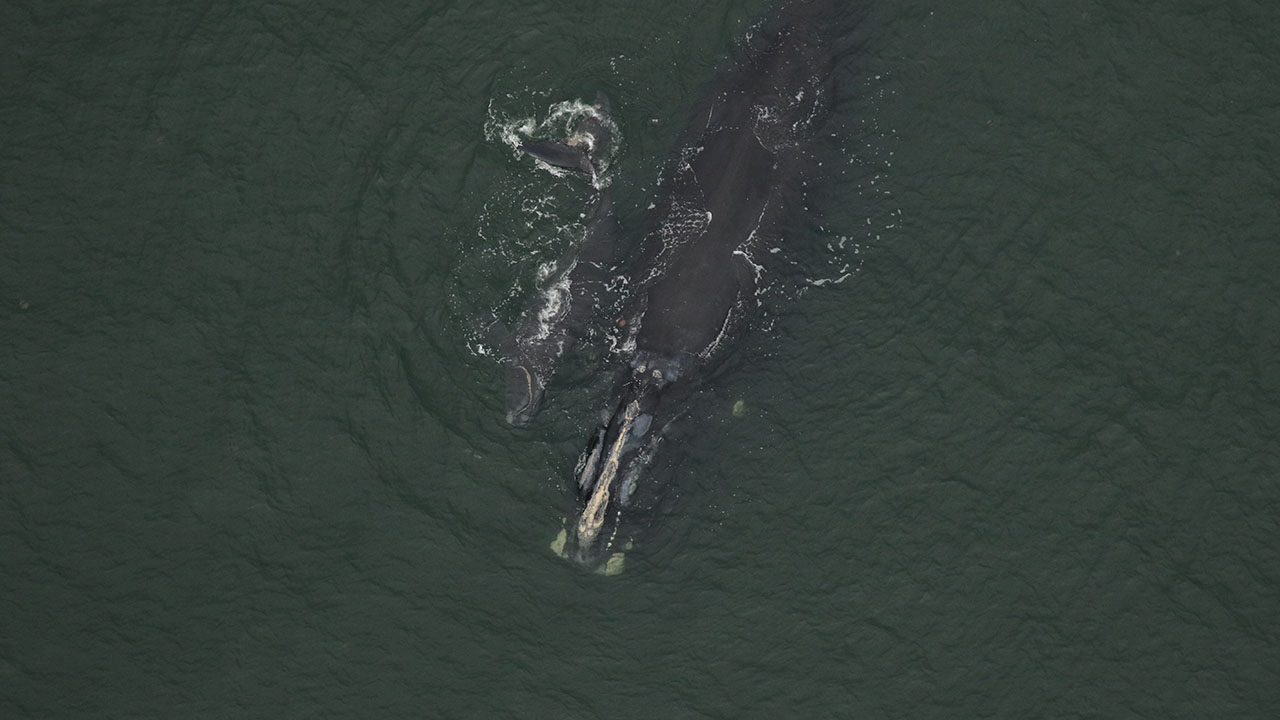
Fenway – #2791
Birth year: Unknown (first seen in 1997)
Age: >27 years old
Last calving year: 2019
Previous calves: 3 (Catalog #3691, Catalog #3991, Catalog #4991)
Other known relatives: N/A
Direct human impacts: 8 entanglements
Human impacts on family members: 8 entanglements
Fenway was seen with her latest calf on January 11, 2024, by Florida Fish & Wildlife. Fenway was first seen in 1997 at an unknown age, and this is her fourth known calf. She was named after the Boston baseball park, home to the Boston Red Sox, because her callosity resembles the shape of a baseball bat. Not much is known about her family since she was first seen on her own, but her two latest calves are still seen regularly. Even though she has a small family, they have experienced 16 entanglements between the four of them, somehow all minor events. Let’s hope they’ve all already seen enough entanglement for a lifetime.
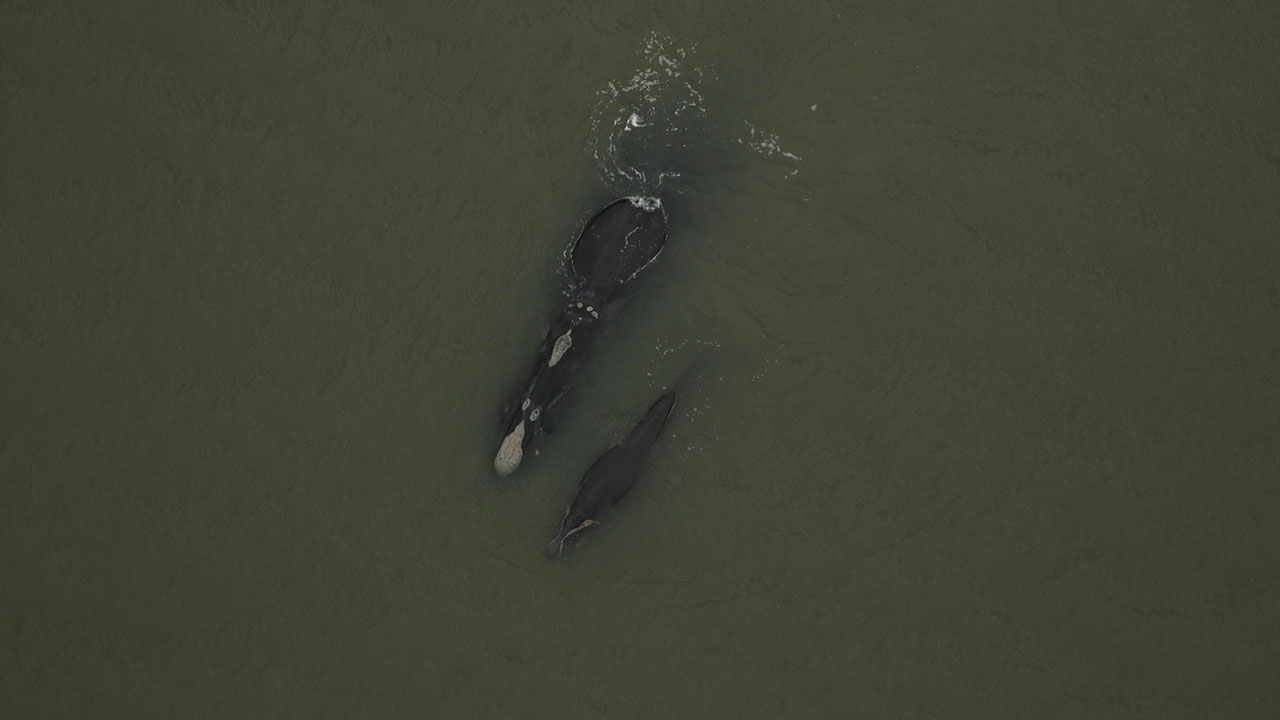
Half Note – #1301
Birth year: 1983
Age: 41 years old
Last calving year: 2022
Previous calves: 7 (Catalog #1931, Catalog #3301 – Neptune, Catalog #3601, Catalog #3801, Catalog #4201, Catalog #4401, and a 2022 calf that has not yet been cataloged.)
Other known relatives: Mother, father, 7 siblings, 13 niece/nephews
Direct human impacts: 2 entanglements
Human impacts on family members: 24 entanglements and 4 vessel strikes (offspring and siblings)
Updated January 18, 2024
Florida Fish & Wildlife reported that Half Note was seen without her calf on January 14. Because it appeared thin at its initial sighting on January 11 and is no longer with its mother, Half Note’s calf is unfortunately presumed dead.
—
Half Note was seen with her eighth known calf on January 11, 2024, by Florida Fish & Wildlife. Half Note was born to mother Fermata (Catalog #1001) and father Catalog #1033. Her mother, Fermata, was the first right whale ever added to the Right Whale Catalog! Half Note was named in honor of her mom’s musical name, and has had seven previous calves. Sadly, only one of them has survived into adulthood. Her son Neptune is currently 21 years old and seen regularly, but he seems to be the anomaly. Her first calf lived to be a year old before disappearing, and all her others were seemingly lost in the calving grounds. Her last five calves have been documented getting skinnier in the calving grounds when they should be growing and gaining weight. Afterward, Half Note is typically seen alone before heading back north, much too early for a calf to be weaned. Researchers wonder if there may be something wrong with Half Note’s ability to nurse or produce milk. Unfortunately, this latest calf is already looking thin and will likely meet the same fate as its late siblings.
Raising young isn’t Half Note’s only concern; she has experienced two entanglements, and her surviving son has dealt with two vessel strikes and three entanglements. In addition, her siblings have seen 20 entanglements and two more vessel strikes. Fortunately, most of these injuries were considered minor, but still, their frequency highlights the need to protect these animals in their ocean home.

Limulus – Catalog #2912
Birth year: 1999
Age: 25 years old
Last calving year: 2013
Previous calves: 2 (Catalog #3712, Catalog #4312)
Other known relatives: Mother, 7 siblings
Direct human impacts: 2 entanglements
Human impacts on family members: 4 entanglements (offspring only)
Limulus was seen with her third known calf on January 11, 2024, by Clearwater Marine Aquarium’s Georgia Team. Limulus is the daughter of Juno (Catalog #1612), the first mom of the current calving season! She is also the only one of her seven siblings to give Juno any grand calves (so far, at least). Limulus was named for the scientific name of a horseshoe crab because of the rounded shape of her head and her callosity pattern.
Between herself and her two previous calves, these whales have seen a collective of six entanglements—and many more in her extended family, mentioned in Juno’s bio below. None of these entanglements were considered severe. Both of her previous calves are still seen regularly and are currently 17 & 11 years old. We wish this new calf the best of luck and hope it will not have to experience the same trauma Limulus’ youngest sibling—Juno’s most recent calf, which was severely injured in an apparent vessel strike—is currently facing. Read on to learn more about Juno’s calf in her bio.

Swerve – Catalog #1810
Birth year: Unknown (first seen in 1988)
Age: >36 years old
Last calving year: 2016
Previous calves: 5 (Catalog #2810, Catalog #3290 – Arrow, Catalog #3794, Catalog #4610, and an uncatalogued calf in 1994)
Other known relatives: 2 grand calves
Direct human impacts: 2 entanglements
Human impacts on family members: 9 entanglements
Swerve was seen with the first calf of the new year on January 3, 2024! The pair was spotted off the coast of Georgia by the Georgia-based Clearwater Marine Aquarium survey team. Swerve was first seen in 1988 at an unknown age, and this is her sixth known calf. Thanks to her eldest daughter Arrow, Swerve has 2 grand calves: Catalog #3990 and a 2020 calf that will hopefully be cataloged soon.
Swerve has a slightly mysterious sighting history as one of those whales who are mostly only documented moms in the calving grounds. She does have a few sightings in the northern feeding grounds, but not many, so perhaps she’s using other feeding grounds between calving years. Given she’s only experienced two minor entanglement injuries in her 36+ years, perhaps she’s found a nice, quiet area to stay healthy! We can only hope she is showing her calves this seemingly safer location as well.
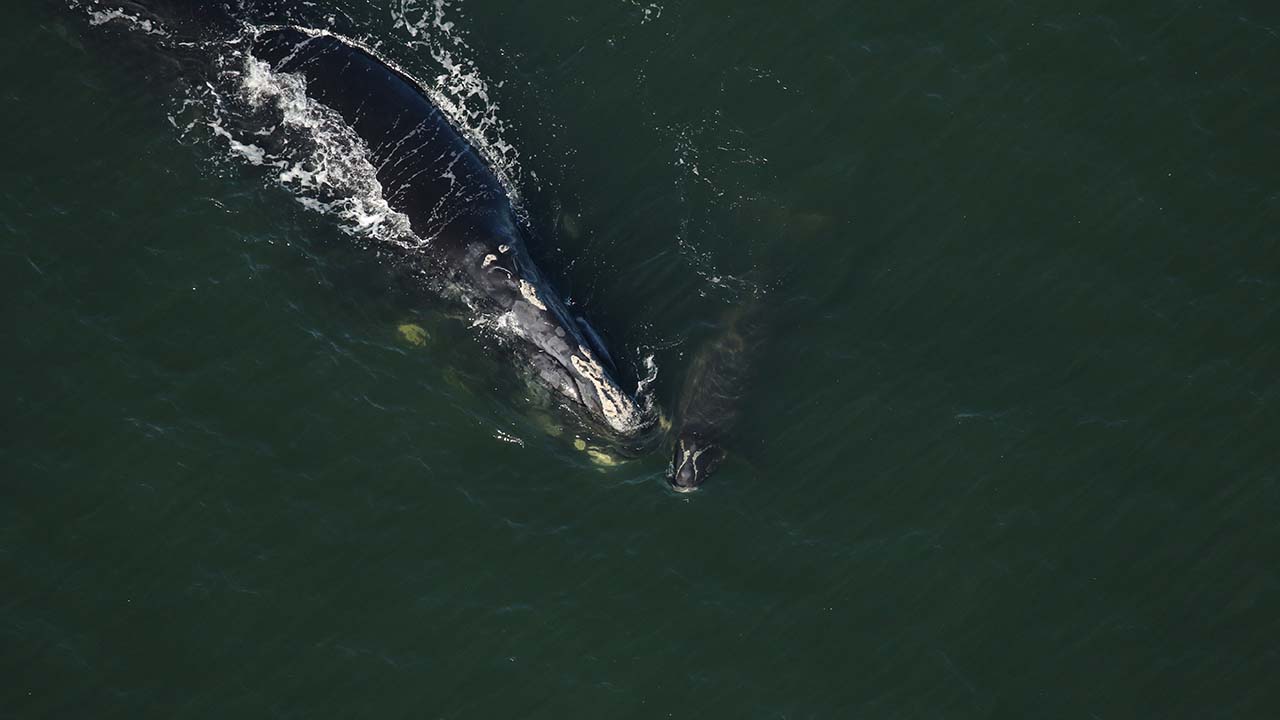
Legato – Catalog #1802
Birth year: 1988
Age: 36 years old
Last calving year: 2011
Previous calves: 4 (#3302, #3602, #3802 – Portato, #4102)
Other known relatives: Mother, 3 siblings, 1 niece
Direct human impacts: 5 entanglements
Family human impacts: 22 entanglements, 3 vessel strikes
Legato (Catalog #1802) was seen with her newest calf on December 31, 2023, by Florida Fish & Wildlife off the coast of Florida. Legato was born to Staccato (Catalog #1014) in 1988, 36 years ago, and this is her fifth known calf. Her name fits into her family’s musical lineage. Legato is a musical notation, indicating notes should be played in a smooth and flowing manner—which also relates to Legator’s callosity pattern and how some of its features flow into others. In addition to her mother’s musical name, a sibling was named ¼ Note (Catalog #1302), Legato’s third calf was named Portato, and her niece was named Arpeggio (Catalog #2753).
Legato and six of her family members have been affected by a combined 27 entanglement events and 3 vessel strikes. Her mother, Staccato, was killed by a vessel strike in 1999, and Legato’s first calf was last seen entangled in 2011 at the age of eight years old. Her second calf died at just a few weeks old. The cause was never determined, but the calf had already been seen with an entanglement injury before its death. Legato’s two most recent calves are still seen regularly, so we will remain hopeful that this latest calf will have a long life and perhaps join in the musical family names.
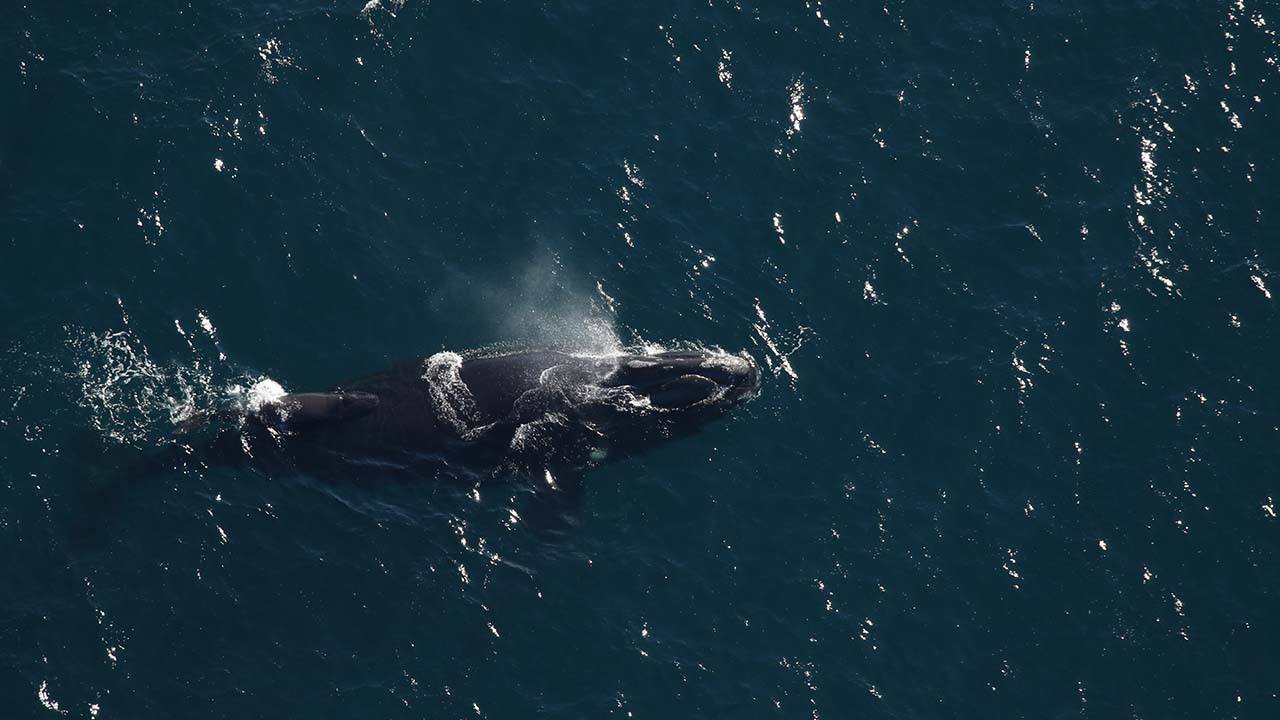
Catalog #3780
Birth year: Unknown (first seen in 2007)
Age: >17 years old
Last calving year: N/A
Previous calves: N/A
Other known relatives: N/A
Direct human impacts: 1 entanglement
Human impacts on family members: N/A
Updated January 12, 2024
Unfortunately, as the Florida Fish & Wildlife Conservation Commission reported, on January 5, 2024, Catalog #3780 was sighted without her calf, which is presumed dead. According to FWC, the calf was seen with its mother only once on December 31, 2023, and was likely less than a day old at the time.
—
Catalog #3780 was seen with her first known calf on December 31, 2023, by the Florida Fish & Wildlife Conservation Commission. Catalog #3780 is our only first-time mom of the season so far! Her history is a bit sparse compared to other whales; she was first seen in 2007 but already appears to be an adult, so her age is unknown. She’s been fairly regularly documented over the past 17 years, mostly in New England waters, but with occasional sightings in the southeast US as well as the Bay of Fundy in Canada. What’s most amazing about Catalog #3780’s sighting history is that she has seemingly avoided human-caused injuries in the 17 years since her first sighting. Her only known entanglement was deemed a minor incident before her initial 2007 sighting. Let’s hope her first calf has the same luck!
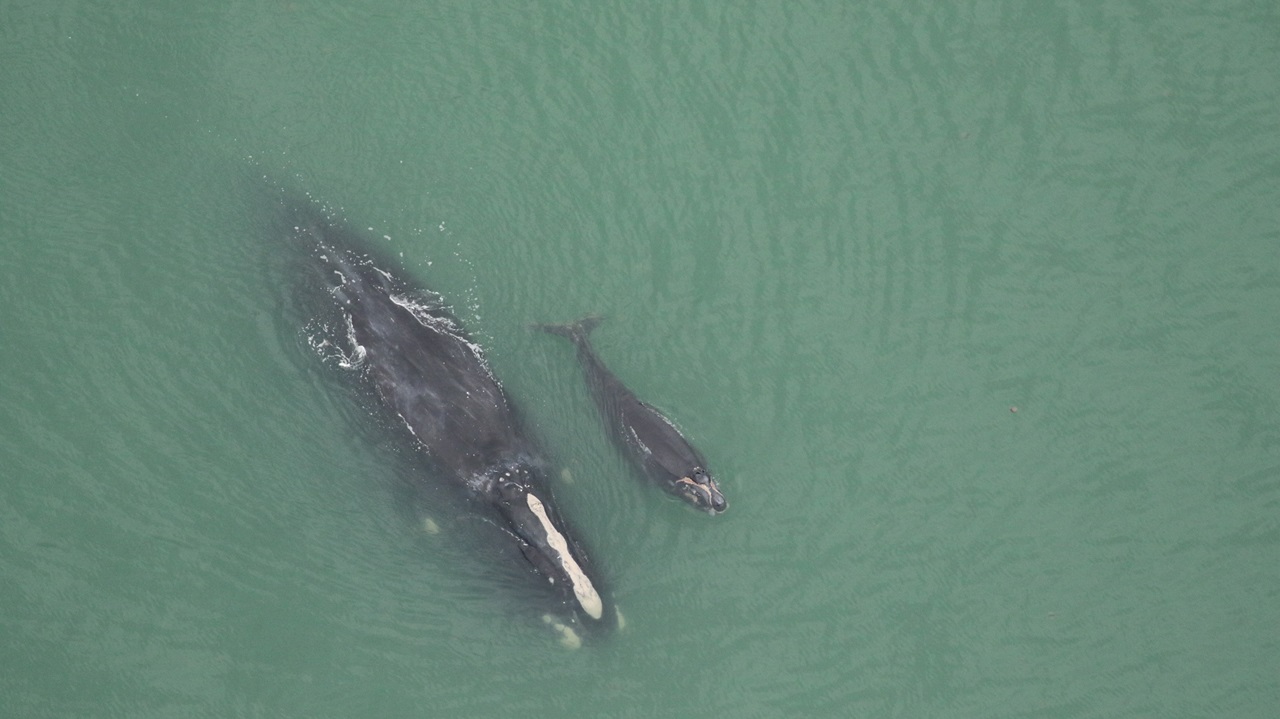
Halo – Catalog #3546
Birth year: 2005
Age: 19 years old
Last calving year: 2020
Previous calves: 2 Catalog #5046 – Jagger, and an uncatalogued calf in 2014)
Other known relatives: Mother, 3 siblings, and 5 nieces/nephews
Direct human impacts: 4 entanglements
Human impacts on family members: 12 entanglements (mother and siblings only)
On December 28, 2023, Halo (Catalog #3546) was seen by Clearwater Marine Aquarium’s Georgia team with her third known calf. Halo was born to mother Loligo (Catalog #1246) in 2005, making her 19 years old. She is one of seven known offspring of Loligo, though three of them were never cataloged. Halo was named for the callosities behind her blowholes, which are arched and positioned as though she’s wearing a halo. Her sister Calamari (Catalog #3946) and son Jagger (Catalog #5046) were just named this year! This latest calf is Halo’s third known calf. She also has five nieces and nephews, thanks to her sister, Catalog #1946.
Halo’s four-year-old son, Jagger, has no documented entanglements yet, but the same can’t be said for the rest of her family. Halo has experienced at least four entanglements; many more are documented among her siblings, mom, nieces, and nephews. Most famously, her nephew Kingfisher was named for his entanglement history, having been entangled six times by the age of eight years old, including a chronic flipper wrap that he obtained at just a year old. This rope around his flipper persisted until his last known sighting in 2015. Calamari and Jagger are Halo’s only relatives who are still seen regularly.
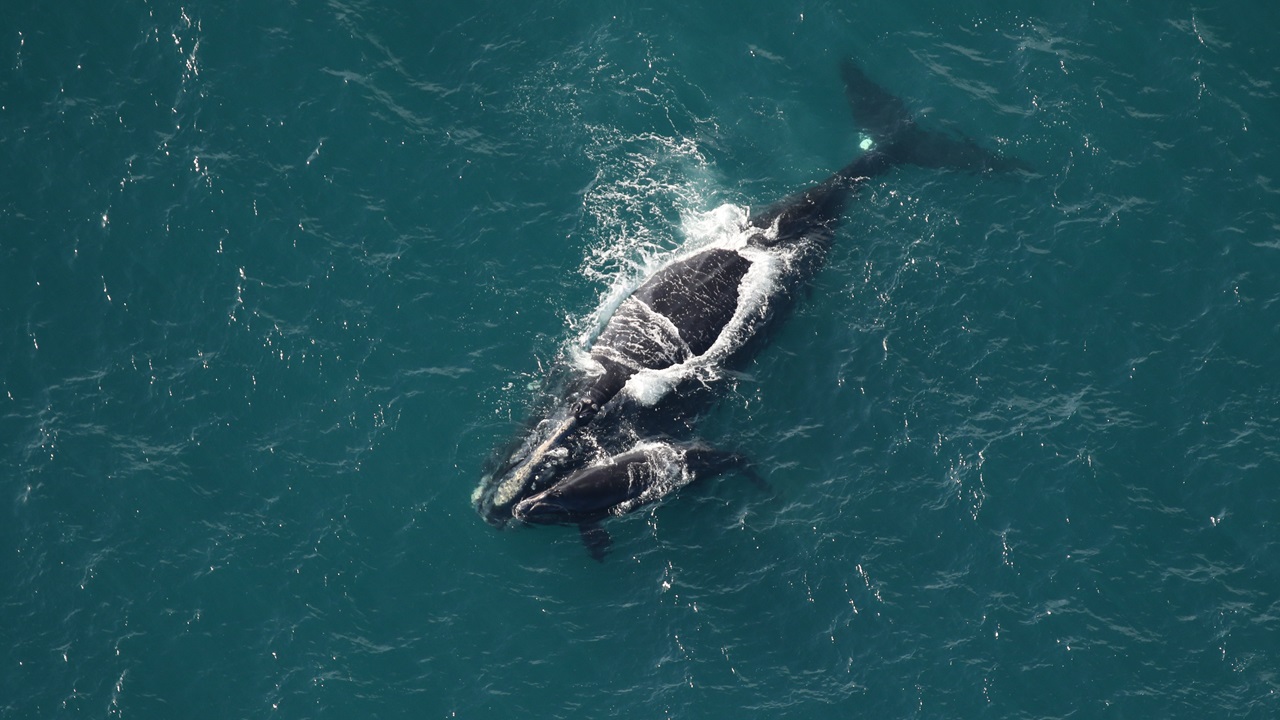
Braces – Catalog #3320
Birth year: Unknown (first seen in 1998)
Age: >26 years old
Last calving year: 2022
Previous calves: 2 (Catalog #3970 and a 2022 calf that has not yet been cataloged)
Other known relatives: Unknown
Direct human impacts: 3 entanglements
Human impacts on family members: 5 entanglements
Braces was seen on December 23, 2023, by Clearwater Marine Aquarium’s Georgia team with her third known calf. This calf came very quickly after her most recent in 2022. Previously, the average time between calving years was around three years, which allowed a year of rest after a year of pregnancy, followed by nearly a year of nursing and weaning. As the right whale population and their general health have declined, the average interval is now closer to ten years between calves. Despite Braces’ three known entanglements, she’s proving that some whales are still capable of keeping up with their historical timeline for giving birth. However, there is a possibility her 2022 calf did not survive, as it was only seen once, and we’ve seen other mothers recently turn around and have another calf quickly after losing one.
Braces is named for the entanglement scars on her lip which make it look like she could be wearing braces. Her seven-year-old calf, Catalog #3970, has had his fair share of entanglements as well—a total of five known entanglements, three of which happened while he was just a calf!
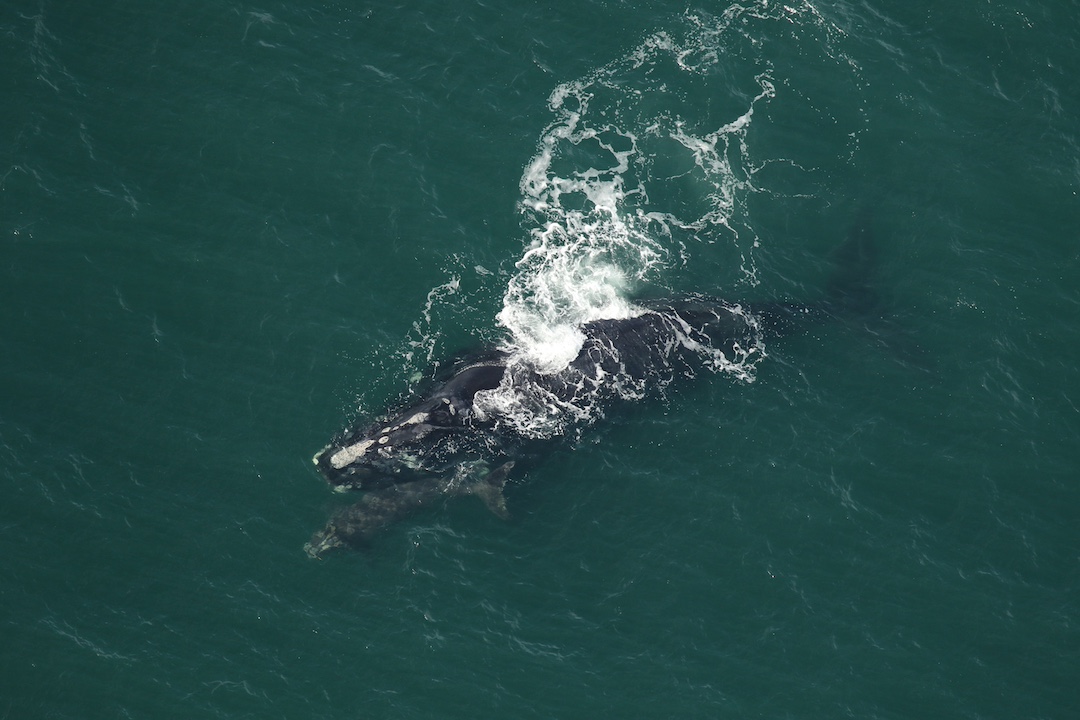
Wolf – Catalog #1703
Birth year: 1987
Age: 37 years old
Last calving year: 2015
Previous calves: 4 (Catalog #3103, Catalog #3503 – Caterpillar, Catalog #3803 – Phantom, and an uncatalogued calf in 2015)
Other known relatives: Mother, father, 6siblings, 4 nieces/nephews
Direct human impacts: 4 entanglements
Human impacts on family members: 7 entanglements and 2 vessel strikes (offspring only)
Wolf is our fourth mom of the season! She was seen with her fifth known calf by Florida Fish & Wildlife off Atlantic Beach, FL, on December 22, 2023. Wolf is named for a group of islands in the Bay of Fundy, Canada, called “The Wolves,” as her callosity pattern can look like a chain of islands. She was a long-time visitor to the Bay of Fundy, once a very popular foraging area for right whales; in fact, it’s where she was first sighted as a calf with her mother Moon (Catalog #1157) in 1987. Thanks to genetics (as male right whales play no role in a calf’s upbringing), we know that Wolf’s father is Catalog #1516. We also know that she has six known siblings, including Cascade (Catalog #3157), who has had three offspring, making Wolf an aunt!
With a larger known family, there is no shortage of injuries documented among Wolf’s relatives. Wolf’s four entanglements are somewhat minor compared to some of her relatives, like her nephew FDR (Catalog #4057), who had been entangled five times by six years old and hasn’t been seen since his last incident in 2016. Her brother Glacier (Catalog #1402) was struck and killed by a vessel in 2017, and her 19-year-old daughter Caterpillar (Catalog #3503) lives with a huge injury from a vessel strike when she was two years old. Researchers fear that her scar will reopen and risk her survival if she becomes pregnant. Let’s hope this new calf can help continue Wolf’s extensive family line!
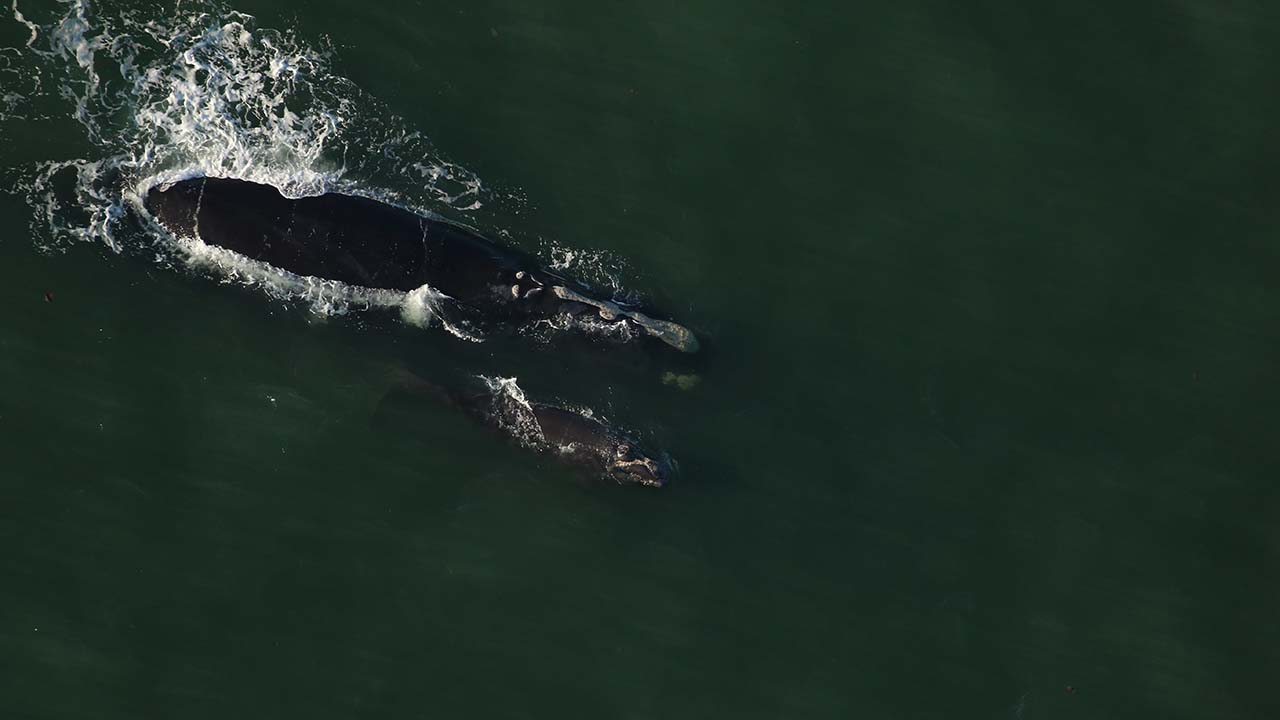
Palmetto — Catalog #1970
Birth year: unknown (first seen in 1989)
Age: >35 years old
Last calving year: 2020
Previous calves: 5 (Catalog #3580, Catalog #5070, and uncatalogued calves in 1996, 2001, 2009)
Other known relatives: Unknown
Direct human impacts: 3 entanglements
Human impacts on family members: 2 entanglements
Palmetto was seen with her sixth known calf by Clearwater Marine Aquarium’s South Carolina team on December 9, 2023. Palmetto is a regular visitor to South Carolina, and it’s actually how she got her name. Part of her callosity pattern looks like a palm tree, and a palmetto palm is represented on the South Carolina state flag. Two of her five previous calves— Catalog #3850 and Catalog #5070—are still seen regularly, but unfortunately, the other three were never seen outside the calving grounds and were not cataloged.
During the intricate process of cataloging a whale, unique identifying features are extremely important to make sure whales are not duplicated. It takes many months for newborn whales to develop these unique features, which means they all look very similar while still in the Southeastern US (SEUS) calving grounds. Genetic sampling can sometimes fill in these gaps, but it’s not always possible to obtain a genetic sample from a calf if they are only seen once and no research vessels are nearby. In recent years, SEUS research teams have been very successful in getting genetic samples from most calves, so hopefully, this newest calf will join its brothers in having a long sighting history.

Horton — Catalog #3360
Birth year: unknown (first seen in 2003)
Age: >21 years old
Last calving year: 2010
Previous calves: 2 (Catalog #3791 – Truffula, Catalog #4090)
Other known relatives: Unknown
Direct human impacts: 4 entanglements
Human impacts on family members: 5 entanglements
Horton is our second mom of the season! She was seen with her third known calf by Clearwater Marine Aquarium’s Georgia Team on December 7, 2023. This calf comes after a nearly 14-year hiatus since Horton’s last calf, possibly due to the two entanglements she’s survived since then—one of them leaving her with extensive scarring on her tail stock. Between her and her two offspring, these whales have been entangled at least nine times. Her latest calf, Catalog #4090, was seen severely entangled in 2011 at just one year old and has never been seen again.
Horton’s name was inspired by the title character in Dr. Seuss’s Horton Hears a Who! In the book, Horton works to save a speck of dust, and the small scar on the whale Horton’s head represents the speck. Her son Truffula—named after the trees in The Lorax—carried on the Dr. Seuss family theme, and perhaps this new calf can, too.
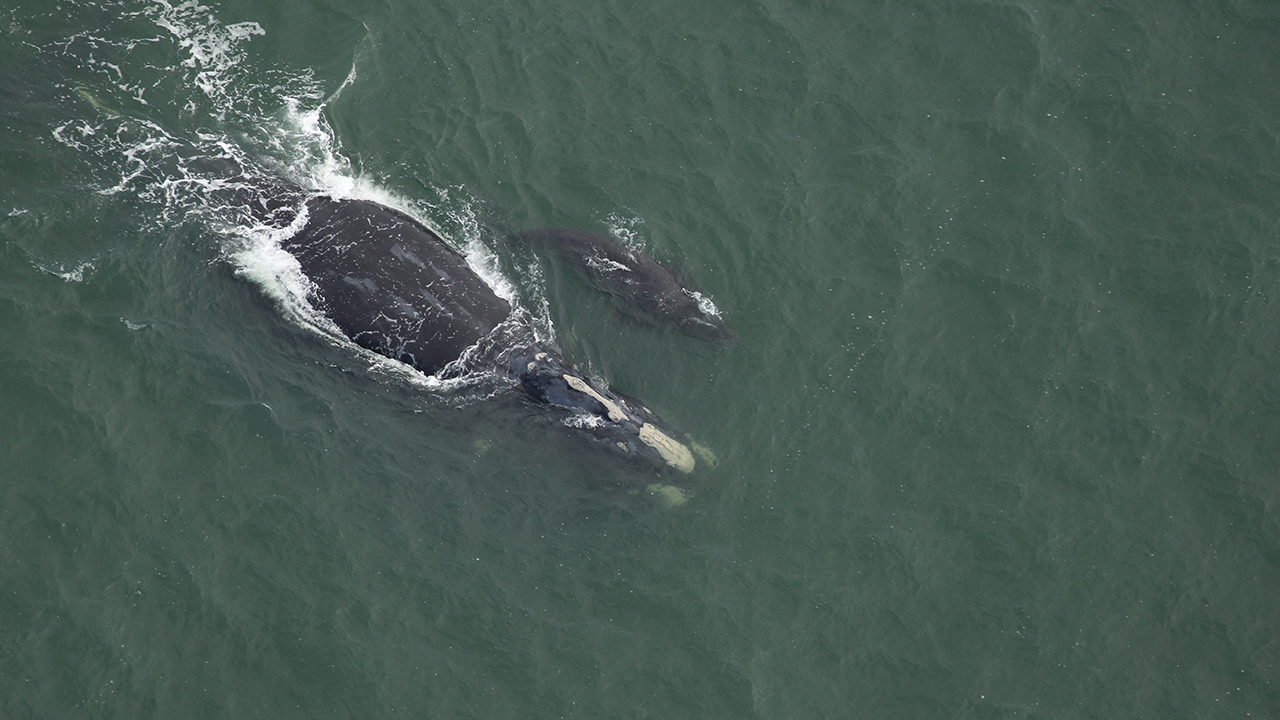
Juno – Catalog #1612
Birth year: unknown (first seen in 1986)
Age: >38 years old
Last calving year: 2020
Previous calves: 7 (Catalog #1613, Catalog #2212, Limulus (Catalog #2912), Catalog #3312, Catalog #3994, Catalog #4540, Catalog #5012)
Other known relatives: 2 grand calves
Direct human impacts: 4 entanglements
Human impacts on family members: 24 entanglements, 2 vessel strikes
Updated March 5, 2024
On March 3, 2024, NOAA Fisheries was notified of a dead right whale stranded on Cumberland Island National Seashore in Georgia. The deceased whale was identified as Juno’s injured calf, which was first seen on January 3, 2024, with severe propeller injuries to its head, mouth, and left lip that were consistent with a vessel strike. A necropsy was performed to evaluate the calf’s wounds.
In a statement from the Aquarium, released in January 2024, after the calf was initially injured, Senior Scientist Amy Knowlton said, “This devastating case brings a heightened sense of urgency to address the significant challenges North Atlantic right whales are facing. It is crucial to act now to implement enhanced regulations to protect this critically endangered species along the US East Coast.” Read our full press release here.
—
Juno is our first mom of the 2024 calving season! She was seen off South Carolina on November 28, 2023, by the Clearwater Marine Aquarium’s South Carolina team. It seems fitting to start the new calving season with an experienced mother, and this is Juno’s eighth known calf. Thanks to her daughter Limulus (Catalog #2912), Juno also has two grand calves.
Juno shares her name with a Roman goddess, which was chosen for her convex-shaped rostrum, which researchers call a “Roman nose.” Juno’s origin is unknown; she was first seen by researchers in the calving grounds in 1986 with her first calf, so she was already of reproductive age. Juno’s large brood is no stranger to struggles as they have collectively dealt with 28 known entanglements and at least two vessel strikes, with six of these events happening before the whale’s first birthday. Fortunately, more than half of her offspring are still seen regularly. Let’s hope this new calf will be able to follow in its mother’s fluke prints and live a long and healthy life!

